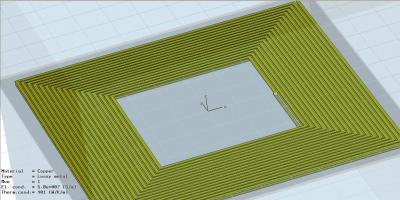Electromagnetism consists of electric and magnetic fields. Sources of alternating current produce these fields.
 This is an illustration of one of cells that make up the metamaterial structure. The yellow lines are copper. Credit: Wenchen Chen and Willie Padilla, Boston College
This is an illustration of one of cells that make up the metamaterial structure. The yellow lines are copper. Credit: Wenchen Chen and Willie Padilla, Boston College
Increasing either one of these fields also increases the other. However, electrical fields that are very high can cause problems to humans and electrical equipment. Electromagnetism is one among the four fundamental interactions in nature, the other being gravitation, weak interaction and strong interaction.
Researchers at the Duke University and Boston College have stated that using metamaterials, magnetic forces may be increased without the corresponding increase of electric current, theoretically. Metamaterials are not single substances but composite man-made exotic materials. They possess a man-made structure and can be fabricated into different shapes and sizes having appropriate properties for a particular function. These materials are being fabricated at Boston College.
The research team comprises assistant research professor in electrical and computer engineering at Duke's Pratt School of Engineering, Yaroslav Urzhumov; associate professor of physics at Boston College, Willie Padilla; and Boston College's physics department researchers, Chris Bingham and Wenchen Chen. Urzhumov works in David R. Smith’s lab at Duke. Smith is the director of Duke's Center for Metamaterials and Integrated Plasmonics and William Bevan Professor of electrical and computer engineering at the college. He had earlier shown that metamaterials designed similarly may act like a cloak to varying frequencies of waves, including light.
This novel discovery holds potential in improving applications such as magnetic levitation trains. Electro-magnets propel these trains. If metamaterials are used instead of these electro-magnets, higher magnetic field intensities can be produced which can levitate higher mass of objects, while using the quantity of electricity that was used before.
Electromagnetism is presently being used in wide applications including destructive weapons and subatomic "optical tweezers," which can maneuver microscopic particles using laser beams.
The study was published online in the journal Physical Review B.